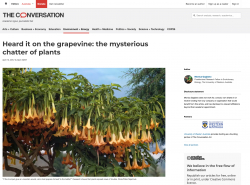Heard it on the grapevine: the mysterious chatter of plants

Type
Publication
Authors
Gagliano ( Monica Gagliano )
Category
Article
[ Browse Items ]
Publication Year
2012
Publisher
The Conversation, Australia
URL
[ private ]
Abstract
Sound and its use in communication have shaped the ecology, evolution, behaviour, and ultimately the success of many animal species. But are animals the only lifeforms to communicate with sound? Do plants also use sound to pass information, and if so, what might this mean in a plant’s life?
The idea of plants being capable of producing, detecting, and using acoustic signals is certainly not new. The study of plant bioacoustics, however, has suffered from the methodological and technological problems of early investigations in the 1940s, and this historical baggage, in conjunction with folkloric reports of the phenomenon, have severely hindered prospects of investigating this aspect of plant ecology.
Bad vibe: Mimosa pudica rolls its leaves away. Flickr/Fayez Closed Account
But we know that plants have evolved to detect and respond to sound waves or vibrations in their environment. A well-known example of this ability is displayed by the rapid leaf-folding action of the sensitive plant, Mimosa pudica. By reducing the leaf area presented to herbivores, while simultaneously making its defensive thorns more visible, this response is widely believed to have evolved to prevent or reduce predation risk.
The ability to respond to vibrations is not unique to M. pudica and many plant species have evolved a range of adaptive strategies to exploit sound. For example, a number of flower families, including that of tomatoes and blueberries, use “buzz” pollination where the pollen is released from flowers only when they are vibrated at the correct ultrasonic frequency, a feat achieved by bees that have co-evolved to vibrate their flight muscles appropriately. Despite the ecological and evolutionary significance of sound in plant-animal interactions, no quantitative information on the mechanisms through which plants detect and respond to sound, and modify their growth accordingly, was available until very recently...
The idea of plants being capable of producing, detecting, and using acoustic signals is certainly not new. The study of plant bioacoustics, however, has suffered from the methodological and technological problems of early investigations in the 1940s, and this historical baggage, in conjunction with folkloric reports of the phenomenon, have severely hindered prospects of investigating this aspect of plant ecology.
Bad vibe: Mimosa pudica rolls its leaves away. Flickr/Fayez Closed Account
But we know that plants have evolved to detect and respond to sound waves or vibrations in their environment. A well-known example of this ability is displayed by the rapid leaf-folding action of the sensitive plant, Mimosa pudica. By reducing the leaf area presented to herbivores, while simultaneously making its defensive thorns more visible, this response is widely believed to have evolved to prevent or reduce predation risk.
The ability to respond to vibrations is not unique to M. pudica and many plant species have evolved a range of adaptive strategies to exploit sound. For example, a number of flower families, including that of tomatoes and blueberries, use “buzz” pollination where the pollen is released from flowers only when they are vibrated at the correct ultrasonic frequency, a feat achieved by bees that have co-evolved to vibrate their flight muscles appropriately. Despite the ecological and evolutionary significance of sound in plant-animal interactions, no quantitative information on the mechanisms through which plants detect and respond to sound, and modify their growth accordingly, was available until very recently...
Description
https://theconversation.com/heard-it-on-the-grapevine-the-mysterious-chatter-of-plants-6292
Number of Copies
1
| Library | Accession No | Call No | Copy No | Edition | Location | Availability |
|---|---|---|---|---|---|---|
| Main | 234 | 1 | Yes |




